The Massachusetts Institute of Technology, known as MIT, is a top private university in Cambridge, Massachusetts. Since 1861, it’s been leading in science and tech. MIT is famous for its new and exciting programs, its important research, and its impact in engineering, science, and more. Over the years, MIT has had more than 100 Nobel Prize winners, 26 Turing Award winners, and many other great minds.
Key Takeaways
- MIT is a prestigious private land-grant research university founded in 1861 and located in Cambridge, Massachusetts.
- The institute is renowned for its innovative programs, groundbreaking research, and impact on various fields, including engineering and science.
- MIT has produced over 100 Nobel laureates and 26 Turing Award winners, among other distinguished scholars and leaders.
- The university is at the forefront of scientific and technological advancements, with a rich history of over 150 years.
- MIT’s innovative and interdisciplinary approach has made it a global leader in research and education.
Introduction to MIT
MIT has a long and interesting history that dates back to 1861. It was created to respond to the United States’ increase in industry. MIT aimed to offer a real-world education in science and technology from the start.
History and Vision
William Barton Rogers and others founded MIT. They combined professional and liberal education in a special way. Their goal was to teach students through hands-on lab work and encourage faculty research.
The history of MIT shows its dedication to innovation and moving forward. Since its beginning, MIT’s vision has been about learning new things and changing how we solve problems.
Motto and Incorporation
The school’s motto is “Mens et Manus,” meaning “Mind and Hand” in Latin. It shows MIT’s focus on both intellectual growth and practical skills. MIT became a private land-grant university, a unique status in the U.S.
“MIT was founded with the vision of providing a practical, hands-on education in science and technology.”
The MIT incorporation and MIT motto guide everything the school does. They influence its courses, research, and goals.
Campus Highlights

The Massachusetts Institute of Technology (MIT) is known for its lively and varied campus. It covers 168 acres in Cambridge, Massachusetts. It sits beautifully by the Charles River. MIT mixes old and new architecture. This makes a lively place for everyone there.
Location and Size
MIT sits in Cambridge, close to Boston. This gives students easy reach to culture and business in both areas. The campus has 19 living places for students, more than 40 acres of gardens, and 26 acres of sports fields. There’s a lot of space for fun and learning.
The Rogers Building, built in the Neoclassical style, stands next to the “New Technology” campus. Designed by William W. Bosworth. The campus shows off more than 60 art pieces. These add to the beauty of MIT.
Student Residences and Green Spaces
MIT works hard to make a welcoming community. With 19 living areas, there’s a place for everyone. Each has its own features, just right for different students.
MIT’s green spots, over 40 acres, are great for breaks. There are nice gardens, paths for walking, and spots to sit. It’s perfect for relaxing and making friends.
Walking around the campus shows MIT’s drive for top-notch learning and innovation. And the lovely green spaces show how much MIT cares about community and well-being.
Admissions Statistics
The Massachusetts Institute of Technology (MIT) is very selective, attracting the best worldwide. For the Class of 2027, it got an awesome 26,914 applicants. Out of them, 1,291 students were welcomed – making the chance of getting in just 4.8%. This shows MIT’s aim to get a diverse, top-notch student community.
MIT’s students come from everywhere, including all 50 states, the District of Columbia, four territories, and 136 foreign countries. This wide representation shows MIT’s dedication to a global learning environment. The MIT admissions process looks for bright, creative candidates ready for MIT’s tough academic challenges.
“MIT’s admissions process is highly selective, but it’s also holistic. We’re looking for students who have the intellectual ability and the drive to excel in our challenging academic environment, as well as the potential to make a positive impact on the world.”
– Stu Schmill, Dean of Admissions, MIT
The MIT acceptance rate for the Class of 2027 highlights its place among the top in the world. As the number and quality of MIT applicants grow, the university keeps its focus. It aims to find and support the future leaders, innovators, and change makers of the world.
Notable Achievements and Honors
 The Massachusetts Institute of Technology (MIT) is famous for creating top scholars and leaders. Its long history shows numerous achievements by its people. This includes those who studied there, taught, and researched.
The Massachusetts Institute of Technology (MIT) is famous for creating top scholars and leaders. Its long history shows numerous achievements by its people. This includes those who studied there, taught, and researched.
Nobel Laureates and National Medals
By October 2023, MIT had 101 Nobel laureates, 61 winners of the National Medal of Science, and 33 who earned the National Medal of Technology and Innovation. These accomplished people have excelled in many areas, making MIT a top global spot for research and innovation.
Turing Award Winners and MacArthur Fellows
Besides the heavier awards, MIT also shines with 17 Turing Award winners and 83 MacArthur Fellows. The Turing Award is the top prize in computer science, while the MacArthur Fellowship is known as the “Genius Grant.” These honors show MIT’s strength in educating brilliant minds.
| Award | Number of MIT Affiliates |
|---|---|
| Nobel Laureates | 101 |
| National Medal of Science | 61 |
| National Medal of Technology and Innovation | 33 |
| Turing Award | 17 |
| MacArthur Fellows | 83 |
MIT’s impressive list of MIT Nobel laureates, MIT National Medal recipients, MIT Turing Award winners, and MIT MacArthur Fellows shows MIT’s strong dedication to excellence. This commitment allows the institute to drive forward research and innovation.
Massachusetts Institute Of Technology

The Massachusetts Institute of Technology, known as MIT, is a top research university in Cambridge, Massachusetts. It was founded in 1861. Since then, MIT has led in science and technology, greatly influencing these fields.
At MIT, different areas of study work together to solve complex problems. The campus runs along the Charles River for over a mile. It also includes off-campus sites like the MIT Lincoln Laboratory, Broad Institute, and Whitehead Institute.
“MIT is a place that doesn’t just create knowledge, but transforms it into action.”
MIT is recognized worldwide for its research and innovation. It’s known for its commitment to making new discoveries and addressing global challenges. This has solidified its place as a top university in science, engineering, and technology.
A Closer Look at MIT
- Established in 1861, MIT is a private, non-profit research university.
- The institute’s urban campus is located in Cambridge, Massachusetts, just across the Charles River from Boston.
- MIT is organized into five schools and one college, offering a wide range of undergraduate and graduate programs.
- The university is renowned for its strengths in science, engineering, and technology, with a strong focus on interdisciplinary research and innovation.
| Key Facts about MIT | Statistics |
|---|---|
| Total Enrollment | 11,520 students |
| Undergraduate Enrollment | 4,602 students |
| Graduate Enrollment | 6,918 students |
| Faculty | 1,054 full-time faculty members |
| Campus Size | 168 acres |
MIT is at the forefront of science, technology, and innovation. It continues to draw the smartest individuals from around the globe to its lively campus.
Faculty and Student Composition
MIT is famous for its top-notch teachers and mixed students. The school has a small student-to-faculty ratio. This means each of its over 1,000 faculty can give a lot of time to their students.
Faculty Profile
The teachers at MIT are leaders in their areas. They are known around the globe for their work. They help students learn to push the limits and think of new ideas. The MIT faculty work hard to make a place where people can collaborate, be creative, and aim for the best.
Student Enrollment and Diversity
In the 2023-24 year, MIT had 4,576 undergrads and 7,344 grad students. The school shows it cares about having many different kinds of people. Nearly half of undergrads and two-fifths of grad students were female. Plus, over half of undergrads and nearly a quarter of grads were from minority groups.
| Metric | Undergraduate | Graduate |
|---|---|---|
| Total Enrollment | 4,576 | 7,344 |
| Women | 49% | 40% |
| U.S. Minority Groups | 58% | 22% |
MIT works hard to be a place where everyone feels welcome. They celebrate the different backgrounds and stories of everyone in their community.
Research at MIT

The Massachusetts Institute of Technology (MIT) is known for leading in MIT research. It has shaped science and technology’s journey. MIT’s work, from high-speed photography in the 1930s to detecting gravitational waves recently, has made a big impact.
MIT is strong in MIT interdisciplinary research. They mix ideas from different areas to solve big issues. This approach has sparked major discoveries and moved MIT to the top globally in research and innovations.
Historical Milestones
MIT has a long tradition of important MIT research. Some key moments are:
- Pioneering high-speed photography in the 1930s, changing how we view fast events
- Making Whirlwind, the world’s first electronic computer in the 1940s, starting the digital revolution
- Helping with the first atomic bomb during World War II
- Detecting gravitational waves first in 2015, proving a key part of Einstein’s ideas
Interdisciplinary Approach
MIT’s work goes beyond just one field. It encourages teaming up across sciences. This mix has led to many innovations, from health to green energy. MIT’s research has made the world better.
“Research is at the core of MIT’s mission, and the institute has played a pivotal role in numerous groundbreaking discoveries and innovations throughout its history.”
MIT’s Role in National Security

The Massachusetts Institute of Technology (MIT) is at the forefront of scientific and technological progress. Its knowledge helps greatly in national security and defense efforts. This was especially true during critical times like World War II.
Vannevar Bush led MIT in supporting defense projects with their top engineering and science. MIT’s involvement in national security has been strong since then. MIT Lincoln Laboratory, funded by the government, keeps doing important research in this field.
MIT has made significant strides in national security by initiating defense research that’s top-notch. The school’s teachers and students have been key in shaping defense innovation. They are driven by a strong duty to safeguard the nation’s interests.
| MIT’s National Security Contributions | Key Highlights |
|---|---|
| World War II | MIT helped fund crucial defense projects during the war. Its deep knowledge in engineering and science benefited national security efforts. |
| MIT Lincoln Laboratory | This lab continues its focus on research for national security and defense, supported by federal funding. |
| Cutting-edge Advancements | MIT’s academic community is heavily involved in national security. Their work pushes boundaries, bringing new ideas and progress. |
MIT’s lasting dedication to national security is central to its reputation. The institute works hard to serve and protect the nation. With its innovative research and expert team, MIT is essential in shaping the future of defense.
“MIT’s contributions to national security have been vital, showing its strong commitment to the public good and national protection.”
Entrepreneurial Spirit
Massachusetts Institute of Technology (MIT) is famed for its entrepreneurial vibe. This culture has sparked many startup successes led by its alumni. Hands-on learning and ties to industry nurture this vibrant startup scene.
Alumni have started many well-known companies, showing MIT’s major business influence. They’ve launched everything from tech leaders like Hewlett-Packard and Intel to new faces like Dropbox and SpaceX.
Notable Alumni Startups
MIT grads have started thriving startups in many sectors. A few examples include:
- Hewlett-Packard – Founded by Bill Hewlett and David Packard, both MIT alumni, in 1939.
- Intel – Co-founded by Gordon Moore and Robert Noyce, both MIT graduates, in 1968.
- Dropbox – Founded by MIT alumni Drew Houston and Arash Ferdowsi in 2007.
- SpaceX – Founded by Elon Musk, who holds a bachelor’s degree from MIT, in 2002.
- iRobot – Co-founded by MIT alumni Colin Angle, Helen Greiner, and Rodney Brooks in 1990.
| Company | Founders | Year Founded |
|---|---|---|
| Hewlett-Packard | Bill Hewlett, David Packard | 1939 |
| Intel | Gordon Moore, Robert Noyce | 1968 |
| Dropbox | Drew Houston, Arash Ferdowsi | 2007 |
| SpaceX | Elon Musk | 2002 |
| iRobot | Colin Angle, Helen Greiner, Rodney Brooks | 1990 |
“MIT’s focus on practical, hands-on education and its strong industry connections have been instrumental in fostering a thriving entrepreneurial ecosystem among its alumni.”
The innovative drive of MIT alumni has profoundly touched global business. Their startup successes continue to lead in technology and innovation, shaping our future.
Academic Programs and Schools
The Massachusetts Institute of Technology (MIT) is known for its many academic offerings. It has a wide range of programs and schools. MIT helps its students look into different areas, getting them ready for many careers.
MIT has five main schools: the School of Science, the School of Engineering, the School of Humanities, Arts, and Social Sciences, the MIT Sloan School of Management, and the School of Architecture and Planning. These MIT schools provide many MIT academic programs. These programs meet the interests and goals of students at the institute.
The School of Science at MIT leads in research and new ideas. It looks into areas like physics, chemistry, biology, and math. Students here get involved in the latest research, improving their problem-solving skills. The School of Engineering is famous for areas like aerospace and computer engineering. Here, students get to work with new technologies. They help find ways to advance technology.
The School of Humanities, Arts, and Social Sciences offers a lively mix of subjects. Students can study literature, economics, and more. This school helps students get better at thinking critically, communicating, and understanding cultures. At the MIT Sloan School of Management, students learn about business. They study management, finance, and how to start a business. This prepares them for leading roles in business.
Lastly, the School of Architecture and Planning focuses on design and cities. Students look at how design, sustainability, and social issues meet. They work on shaping the future of architecture and city planning. Through its many MIT academic programs and MIT schools, MIT helps students become leaders and innovators. They are ready to take on the challenges of today and tomorrow.
Also Read : How Can I Get A University Scholarship?
Conclusion
The Massachusetts Institute of Technology (MIT) stands out worldwide in higher education. It is known for its groundbreaking innovations and drive for new discoveries. Through its distinct history, brilliant minds, and dedication to the highest standards, MIT is changing the science and technology worlds.
MIT is more than just a place in Cambridge. Its influence spreads globally, thanks to its innovative research and leading-edge programs. The great minds at MIT have won Nobel prizes and Turing Awards and have formed a wide-reaching network through its alumni. This forms MIT’s well-earned reputation for top-notch accomplishments and lasting contributions.
MIT is at the forefront of progress in areas like AI, green energy, and health. Its tireless effort in expanding knowledge and pushing the limits has confirmed its role in advanced learning. Amid tough global problems, MIT remains a leader, offering creative answers and guiding the path forward for upcoming generations.
FAQs
What is the Massachusetts Institute of Technology (MIT)?
MIT is a top private university in Cambridge, Massachusetts. It opened in 1861 and has led in science and tech for 150 years.
What is the motto and incorporation of MIT?
The motto at MIT is “Mens et Manus,” meaning “Mind and Hand” in Latin. It shows MIT’s commitment to applying knowledge. MIT is also noted as a private land-grant, one of three in the U.S.
Where is the MIT campus located, and what are its features?
MIT is in Cambridge, next to the Charles River, covering 168 acres. It blends historic and modern buildings and includes student housing. There are also large gardens, creating a lively setting.
What are the admissions statistics for MIT?
In 2027, MIT got 26,914 applications but only admitted 1,291. This makes MIT one of the most selective schools.
What notable achievements and honors are associated with MIT?
MIT is proud of its many scholars and leaders. By October 2023, it saw 101 Nobel winners, among others. It also celebrated 17 winners of the Turing award, a top computer prize.
What is the overview of the Massachusetts Institute of Technology?
MIT is well-known for leading in science and technology. It was founded in 1861 in Cambridge, Massachusetts. Since then, it’s been a key player in many tech and science advances.
What is the faculty and student composition at MIT?
MIT has about 1,000 professors known for their research and teaching. Its student community includes over 11,000 students. Women make up nearly half of undergrads. Many from U.S. minority groups join MIT as well.
What is the focus on research at MIT?
Research is central at MIT, leading to many discoveries and innovations. It brings together students and experts from across the MIT community. Together they address big world problems.
What is MIT’s involvement in national security and defense-related research?
MIT has a long history in military and security research, especially during World War II. Today, its Lincoln Lab is still a key player in these areas.
Source Links
- https://www.mit.edu/about/
- https://facts.mit.edu/research-highlights/
- https://en.wikipedia.org/wiki/Massachusetts_Institute_of_Technology




